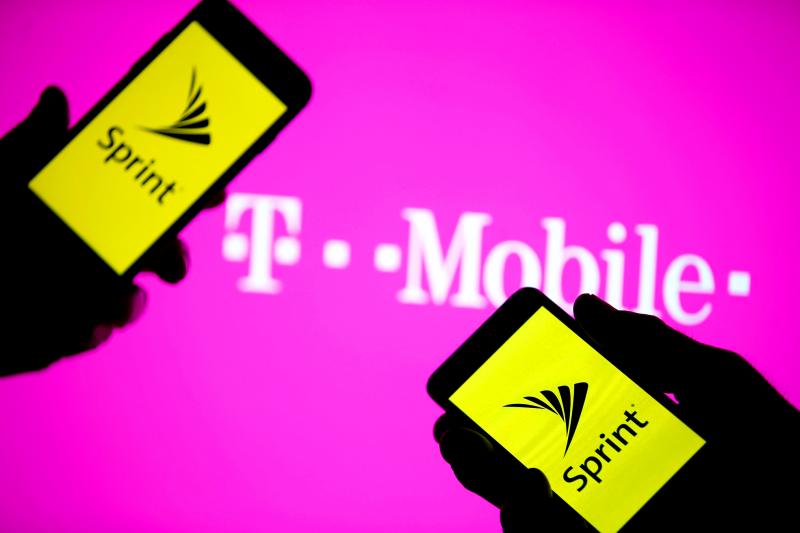T-Mobile USA Inc on Wednesday completed its US$26.5 billion acquisition of Sprint Corp, a years-long saga that included a stare-down with US anti-trust officials, a court battle with state attorneys general and a virus crisis that has brought the US to a near standstill.
While the COVID-19 pandemic is far from over, Sprint chairman Marcelo Claure last week said in an interview that the new T-Mobile is arriving at a good time to offer lower-priced wireless options to consumers battered by economic damage.
“This will be a tough crisis for the world and Americans to absorb,” Claure said. “But at the end, every single person in the US needs their mobile phone.”

Photo: Reuters
Combining the nation’s two most aggressive wireless competitors was a fraught proposition from the start. It drew opposition from consumer groups, unions, politicians and regulators. Wall Street only gave it 50-50 odds. Then the spread of the coronavirus closed stores and forced executives, lawyers and officials from 16 banks to try to finish the deal remotely, most working from home.
The journey started more than six years ago and almost immediately hit a wall. The vibrant wireless industry had four competitors and Washington was dead-set against reducing it to three.
A series of setbacks ensued, including a bitter dispute over ownership structure, a new executive team, a secret meeting at a pizza shop in Hoboken, New Jersey, and a return to the table with new resolve, several people familiar with the situation said.
SON’S IDEA
Softbank Group Corp in 2013 bought Sprint for US$22 billion.
In February 2014, Masayoshi Son, chairman of both Sprint and Softbank, met with regulators in Washington to sell them on his idea that Sprint and T-Mobile together could provide a formidable third competitor to the dominant duo of Verizon Communications Inc and AT&T Inc.
Son’s plan got a chilly reception from regulators in the administration of then-US president Barack Obama.
Meanwhile, Deutsche Telekom AG’s US mobile unit T-Mobile had been rapidly recovering from its failed takeover by AT&T in 2011.
Much of its success was due to then-CEO John Legere, a 20-year industry veteran who reinvented himself as the rebellious, shaggy-haired leader and mascot of the company. His deft social-media skills and an unending arsenal of marketing plans fueled an underdog assault on “Dumb and Dumber” — his name for AT&T and Verizon.
Starting at a distant fourth place in its wireless peer group, T-Mobile soon became the fastest-growing carrier. With the arrival of the iPhone, improved network performance and enticements like video and music streaming, the company leapfrogged Sprint to become the No. 3 US carrier.
Deutsche Telekom and Softbank were close to an agreement to merge T-Mobile and Sprint, but eventually walked away due to the regulatory risk. During this time, Sprint was still losing money and customers.
Disheartened, Son briefly explored selling the company, but later resolved to pursue his original plan with even more determination. He in August 2014 hand-selected Claure to lead the company and they drew up a five-year plan to stabilize the business, staunch its losses and make it attractive enough to swing a deal.
CLANDESTINE SLICES
US President Donald Trump’s election in November 2016 gave them a new opening in Washington. Claure and Legere agreed to meet. Not wanting to be spotted together, they decided to rendezvous in Hoboken, across the river from New York City.
They were not friends — Claure had sniped at Legere amid an August 2016 Twitter spat: “You truly are a con artist.”
They met at Grimaldi’s Pizzeria on Washington Avenue. The dark tavern with high-back booths allowed the kind of privacy they needed. They discovered that they had similar goals, and by the end of the conversation they reached an agreement to start working toward a merger. It was a crucial first step in a multi-round negotiation.
On Dec. 6, 2016, a month after Trump’s election, Son visited Trump’s Fifth Avenue office in Manhattan and pledged to invest US$50 billion in new companies and create 50,000 jobs. It was an obvious homage to a new business-friendly leader and a gesture that could help Son’s plans in the US.
Within a year, T-Mobile and Sprint had a deal ready. To celebrate, Legere, Claure and Deutsche Telekom CEO Tim Hoettges flew to Tokyo to have dinner with Son.
Instead of reveling, Hoettges and Son tangled over who would control the combined company. The impasse could not be fixed and for the second time, the deal was discarded.
Talks took a brief hiatus, but were soon back on again. The prospects of 5G technology gave the merger even more impetus. The combination of T-Mobile’s low-band airwaves and Sprint’s mid-band ones would create the largest US holding of ready-to-build 5G network capacity.
On April 29, 2018, the two companies announced the deal. With all the terms finally ironed out, the next step — regulatory review — would prove to be equally challenging.
‘WAR ROOMS’
The battle plan called for “war rooms” to be set up in Washington, where T-Mobile executive vice president of corporate services Dave Carey would oversee teams from both companies.
During negotiations with officials from the US Federal Communications Commission (FCC), the executives camped out at the Mandarin Oriental hotel near the FCC offices in downtown Washington.
About a year after announcing the deal, the companies had secured a key regulatory victory: FCC Chairman Ajit Pai recommended deal approval with conditions, including divestiture of Sprint’s prepaid brand Boost, 5G build-out commitments and a price freeze for at least three years.
After the FCC recommendation, the companies moved their deal teams to the Willard Hotel, a short walk from the US Department of Justice’s headquarters on Pennsylvania Avenue, where the final stage of the review took place.
Makan Delrahim, a Trump administration appointee and the head of the department’s anti-trust division, was not ready to sign off on the deal. Delrahim was not a fan of conditions and conduct requirements that put the onus on agency staff to police the agreements, preferring cleaner remedies like divestitures. He also did not like reducing the number of competitors in the market.
However, the deal presented a unique opportunity if the companies could pull it off: let T-Mobile and Sprint combine their networks and spectrum to take on AT&T and Verizon, while at the same time setting up a new competitor that had the wireless airwaves needed to build a network.
HELPFUL OPPONENT
Dish Network Corp, at first a major opponent of the deal, was the key to getting it through.
Dish cofounder and chairman Charlie Ergen had a track record of creating disruptive businesses, from his flagship satellite TV operation to streaming pioneer Sling TV, and was known as a shrewd negotiator. In a dispute with AT&T, Dish became the first TV distributor to black out HBO, one of the world’s most popular TV networks.
Dish had amassed US$20 billion of airwaves over the past decade, with the goal of building or acquiring an advanced nationwide wireless network for 5G.
With Delrahim wanting to set up a competitor with its own network, Dish was really the only logical choice to buy assets from T-Mobile and Sprint and get the deal across the finish line.
In May 2018, the day after Pai recommended approval of the deal, Ergen and Delrahim met to discuss how Dish could be the basis of the remedy.
One of the key obstacles was that Ergen needed FCC approval to extend regulatory deadlines tied to the spectrum Dish owned.
In June 2018, Delrahim told Ergen in a text: “Today would be a good day to have your senator friends contact the chairman,” a reference to Pai.
Ergen spoke with US Senator Cory Gardner and US Senate Majority Leader Mitch McConnell.
As negotiations with Delrahim were heating up, a group of attorneys general led by New York and California sued to block the deal.
The consolidation would remove choices, raise prices and stifle innovation, and the fallout would affect poorer people most, they said.
The move presented a potentially insurmountable obstacle to the deal that hung ominously over the review process.
Talks with Delrahim hit a standstill over final details of the Dish remedy. That is when Claure rushed to the department’s headquarters to meet Delrahim in his office.
Delrahim gave him a stark choice: take the settlement the department wanted or face a lawsuit. Claure gave in.
Now Ergen is vowing to take on the industry.
“There’s an old saying — I think this is an [former US president] Abraham Lincoln quote — but if you are going to chop down a row of trees and you got six hours to do it, spend the first four hours sharpening your ax,” Ergen told the judge who ultimately rejected the states’ lawsuit and approved the deal.
“We spent 10 years sharpening a pretty sharp ax to go and compete, and this particular transaction is the catalyst that allows us to do that in a much faster manner than we thought,” he added.

Stephen Garrett, a 27-year-old graduate student, always thought he would study in China, but first the country’s restrictive COVID-19 policies made it nearly impossible and now he has other concerns. The cost is one deterrent, but Garrett is more worried about restrictions on academic freedom and the personal risk of being stranded in China. He is not alone. Only about 700 American students are studying at Chinese universities, down from a peak of nearly 25,000 a decade ago, while there are nearly 300,000 Chinese students at US schools. Some young Americans are discouraged from investing their time in China by what they see

MAJOR DROP: CEO Tim Cook, who is visiting Hanoi, pledged the firm was committed to Vietnam after its smartphone shipments declined 9.6% annually in the first quarter Apple Inc yesterday said it would increase spending on suppliers in Vietnam, a key production hub, as CEO Tim Cook arrived in the country for a two-day visit. The iPhone maker announced the news in a statement on its Web site, but gave no details of how much it would spend or where the money would go. Cook is expected to meet programmers, content creators and students during his visit, online newspaper VnExpress reported. The visit comes as US President Joe Biden’s administration seeks to ramp up Vietnam’s role in the global tech supply chain to reduce the US’ dependence on China. Images on

Taiwan Transport and Storage Corp (TTS, 台灣通運倉儲) yesterday unveiled its first electric tractor unit — manufactured by Volvo Trucks — in a ceremony in Taipei, and said the unit would soon be used to transport cement produced by Taiwan Cement Corp (TCC, 台灣水泥). Both TTS and TCC belong to TCC International Holdings Ltd (台泥國際集團). With the electric tractor unit, the Taipei-based cement firm would become the first in Taiwan to use electric vehicles to transport construction materials. TTS chairman Koo Kung-yi (辜公怡), Volvo Trucks vice president of sales and marketing Johan Selven, TCC president Roman Cheng (程耀輝) and Taikoo Motors Group

New apartments in Taiwan’s major cities are getting smaller, while old apartments are increasingly occupied by older people, many of whom live alone, government data showed. The phenomenon has to do with sharpening unaffordable property prices and an aging population, property brokers said. Apartments with one bedroom that are two years old or older have gained a noticeable presence in the nation’s six special municipalities as well as Hsinchu county and city in the past five years, Evertrust Rehouse Co (永慶房產集團) found, citing data from the government’s real-price transaction platform. In Taipei, apartments with one bedroom accounted for 19 percent of deals last